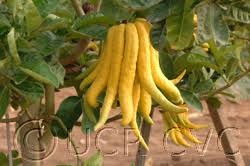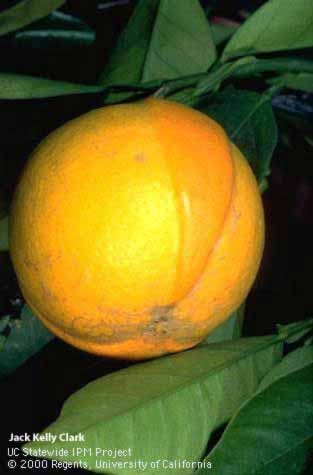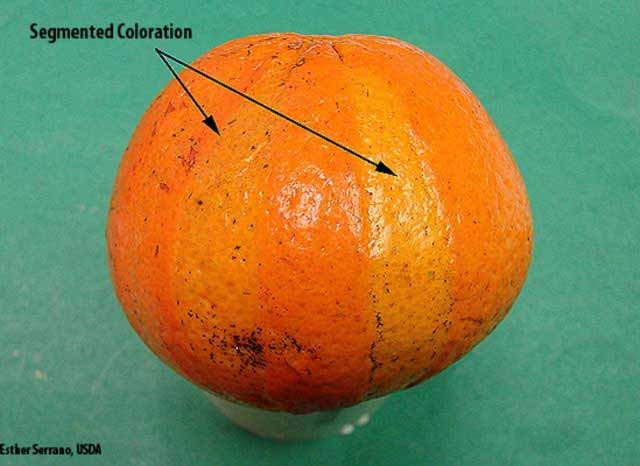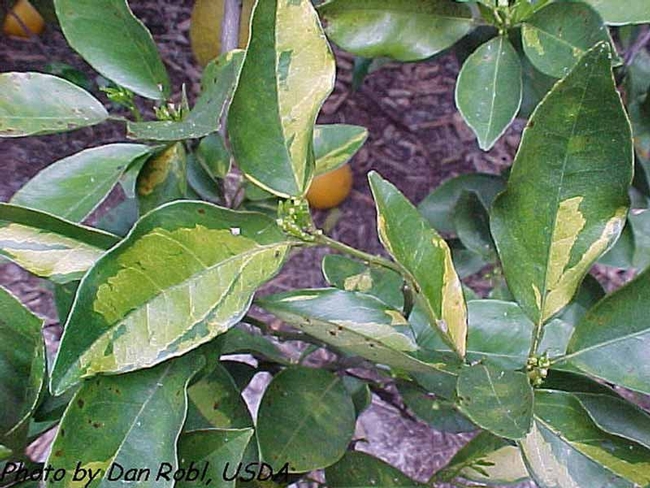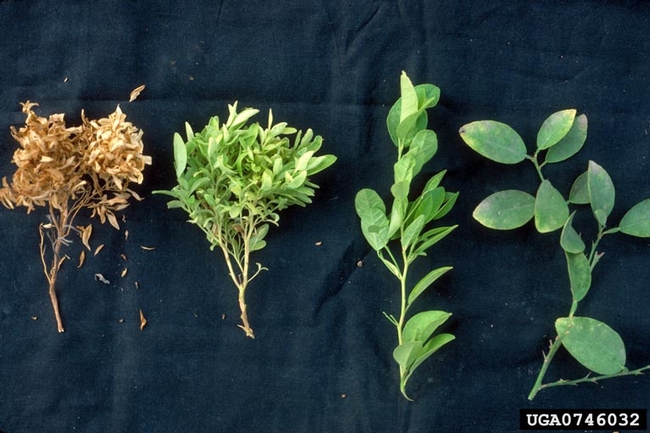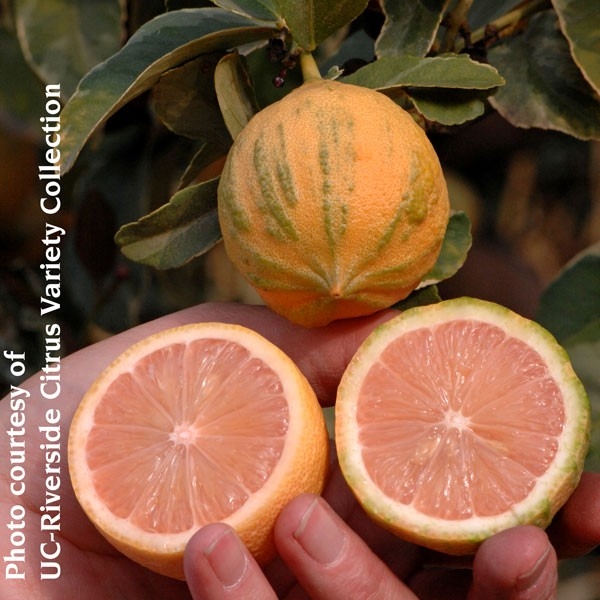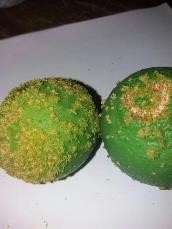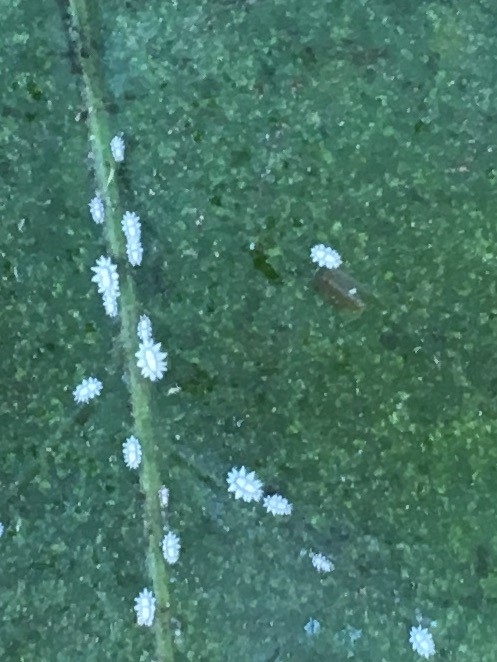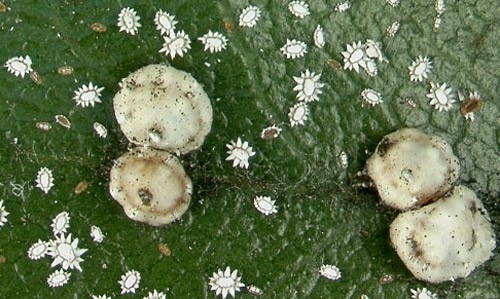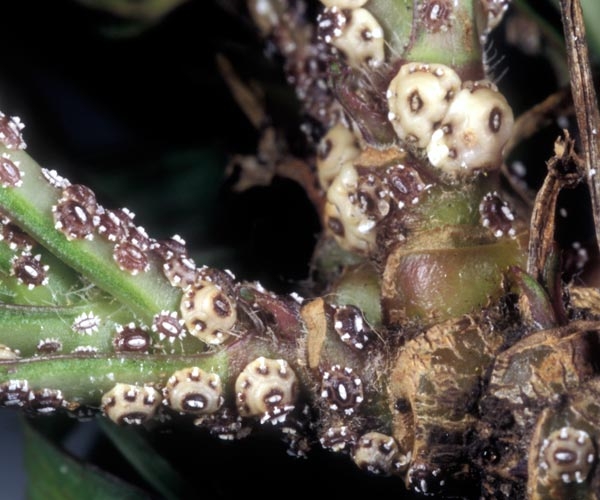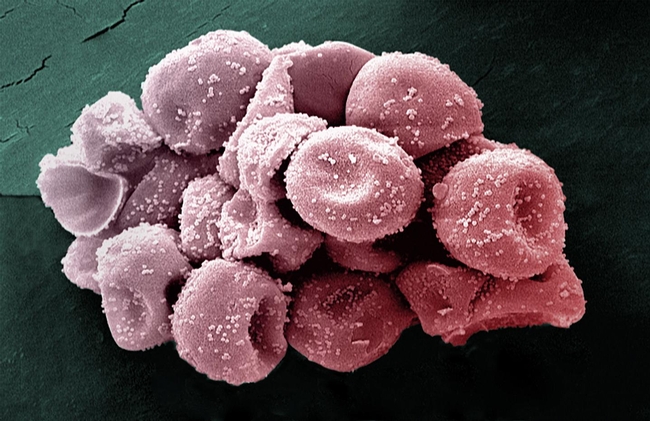The whole group of plants we lump under the taxonomic classification of citrus are really changeable. It's out of this changeability that we get new varieties. Some of these can be quite fanciful, almost dream like fruit which is where the origin of the name chimera comes from. Buddha's Hand is a pretty dream-like fruit.
These changes are a genetic mutation that occurs in a branch or twig, and if that tissue survives, it can produce new shoots (called sports or chimera) with characteristics different from the those of the mother tree. These mutations can affect the color of the rind or pulp or the shape of the fruit.
Leaves on these twigs can have a different shape or size have a variegated color.
Mutations can cause the development of multiple buds, creating bunchy growth or “witches' broom.”
A chimera can produce an improved crop: some of today's cultivars were propagated from chimeras, such as the variegated pink lemon.
Usually sports are of inferior quality and should be avoided as propagation material. Prune sports that obstruct normal growth or interfere with harvest.
But some of them are so weird you just want to keep them around. This one showed up on one and only one tree branch in a lemon orchard. It looks like citrus scab, sort of, but on only one branch of one tree.
Some of the changes that you see in a tree can also be symptoms of a whole lot of other problems, like nutrients, Huanglongbing or herbicide damage. Check out some of the symptoms:http://ipm.ucanr.edu/PMG/C107/m107bpfruitdis.html
Some chimeras are yet to be found out. This image of spiral tattooing showed up for several years ago in a Meyer lemon orchard. It was erratic and inconsistent in a tree, not typical of a chimera. The orchard was finally removed because it wasn't making money. Now it just seems like a dream and will never know if it was a true chimera.
Posted on
Monday, November 27, 2017 at
7:22 AM
Task Force ACP-HLB update
HLB update
To date, 232 residential citrus trees in Southern California have tested positive for the HLB bacterium. All have been, or are being, removed. Most were in neighborhoods in LA and Orange counties. Three of the trees were in Riverside, and although they were residential trees, the resulting 5-mile radius quarantine for HLB is affecting a few growers in Riverside and San Bernardino counties.
The latest HLB quarantine map with the running tally of HLB detections in the state can be found at the Citrus Insider website: https://citrusinsider.org/maps/. The maps are updated every week.
Tree removal
As HLB detections increase and spread closer to commercial citrus, it is a good time to consider removing any citrus trees that are unloved, uncared for, or not worth the time and resources required to protect them from ACP and HLB. Untreated citrus can serve as a reservoir for ACP and possibly the disease HLB, increasing the risk to other citrus in the area. The Citrus Matters ACT NOW program may be able to assist with tree removal at little or no charge to you. Find more information at: https://citrusmatters.cropscience.bayer.us/commercial-grower/act-program. Or if you need referrals for tree removal services, contact Sandra or Cressida.
ACP-HLB program meetings
The California Citrus Pest & Disease Prevention Committee (CPDPC) is made up of growers and other representatives of the citrus industry, working with the California Department of Agriculture (CDFA) and others. The CPDPC is funded in large part by grower assessments and steers the statewide effort to protect our citrus from ACP and HLB. The full committee meets every other month, with subcommittees meeting in between. All committee and subcommittee meetings are public and open to anyone to attend or listen remotely via computer or phone. Agendas for upcoming meetings and minutes from previous meetings are posted on the CDFA website: https://www.cdfa.ca.gov/citruscommittee/.
Coastal citrus representative needed for CPDPC
There is an opening for a grower representative from the coast to serve on the CPDPC. Be a part of deciding how grower funds are spent to protect our industry. Details can be found here: https://www.cdfa.ca.gov/egov/Press_Releases/Press_Release.asp?PRnum=17-069.
Santa Paula crew boss workshop
On Wednesday, Nov. 29, the Citrus Pest & Disease Prevention Program and California Citrus Mutual are hosting a free train-the-trainer workshop in Santa Paula. This Spanish-only workshop for crew bosses, ranch managers, etc., focuses on preventing human-aided spread of ACP and HLB. It has been approved by the Department of Pesticide Regulation for 2 hours of continuing education in the "other" category. For details see:
https://citrusinsider.org/2017/11/santa-paula-crew-boss-workshop/#more-2956
Feel free to contact your ACP-HLB grower liaisons if you have any questions or need assistance:
Cressida Silvers
cressidasb@gmail.com
(805) 284-3310
and
Sandra Zwaal
szwaal2@gmail.com
(949) 636-7089
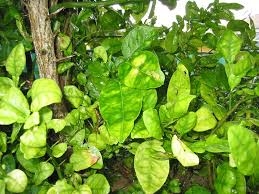
HLB symptoms
Posted on
Friday, November 17, 2017 at
5:55 AM
Tags:
ACP (145),
Asian Citrus Psyllid (76),
citrus (468),
grapefruit (26),
HLB (132),
huanglongbing (97),
lemon (106),
mandarin (71),
navel (13),
orange (69),
tangerine (3),
Valencia (5)
Recently a grower called up with a beautiful scale that the PCA couldn't identify. I could just marvel at the beauty of it and wondered what in the heck it was. It didn't look like any scale I had seen in the area and others who were queried didn't know either.
I took it into the Ag Commissioner's office and they sent it off to see if it was a new species. Images were sent off to various entomologists and David Haviland in Bakersfield identified it as a Ceroplastes, possibly a Chinese wax scale or Barnacle scale. Others had identified it as Florida wax scale.
It was sent into Paul Rugman-Jones at UC Riverside Entomology for DNA identification. His identification and that of CA Dept of Food and Ag entolomogists came back as Barnacle scale, Ceroplastes cirripediformis.
All of these scales turned out to have been seen in California before, so there was no quarantine issue. It also turned out that all of the adults that were turned in for identification had also been parasitized by some wasp. So there is biological control already in place for it. The issue at stake here, though, is that it's important to be watching for new visitors in the orchard. Joe Morse now retired from UC Riverside Entomology lead a team that intercepted avocados coming into the US. They found a number of scale insects that were new to California and new to the identification world. A number of these scale are parthenogenic, meaning they can reproduce without males, and just one lone female could possible balloon into a massive population in a short time. And on a scale like that, trees would have a hard time without some serious intervention.
Posted on
Friday, September 29, 2017 at
6:46 AM
IMAGE: Orbicules or "Ubisch bodies " (300 - 600nm granules), characteristics of Cupressaceae pollen, are visible on the surface of the exine (outer membrane). view more
Credit: Youcef Shahali / Colorization Jean-Marc Panaud, Institut Pasteur
Palynology - the study of pollen
Exine - the outer coating of a pollen grain
Orbicules - lipid droplets excreted onto pollen surface
Working in collaboration with teams from the Czech Republic and Japan, researchers from the Institut Pasteur, Assistance Publique - Hôpitaux de Paris (AP-HP), and Assistance Publique - Hôpitaux de Marseille (AP-HM) have identified, for the first time, the likely origin of the cross-reactivity between cypress pollen, peaches and citrus fruits. Their work has shown that these sources contain allergens belonging to a new family of proteins involved in pollen food associated syndrome. This discovery, which was published in JACI on August 3rd, paves the way for the development of novel allergy diagnostic tests.
Today, more and more people suffer from allergies, especially in industrialized countries (where almost 30% of the population is affected). In view of this, doctors are observing an increase in cases of "pollen food associated syndrome", or "combination" allergies, i.e. those which occur via a cross-reaction between pollen (respiratory allergies) and food (food allergies).
In Mediterranean regions, allergic reactions to cypress pollen/peach and cypress pollen/citrus fruits have been described in clinical practice. In such cases, certain people, having been exposed and sensitized to cypress pollen from a young age, go on to develop allergies to citrus fruits and peaches in adulthood. It is estimated that 60% of food allergies occur in combination with respiratory allergies.
Although several explanations had been put forward regarding the increase in these combination allergies, such as environmental or lifestyle changes, the structural basis for the cross-reaction between cypress pollen and certain fruits had, until now, not been formally identified.
A translational study (combining clinical observation and academic research), directed by researchers from the Institut Pasteur and AP-HP, working in partnership with teams from the Prague University of Chemistry and Technology (Czech Republic) and Hokkaido University (Japan), and also the Pneumo-Allergy Unit at La Timone Hospital in Marseille (AP-HM), has revealed for the first time the underlying physicochemical and immunological mechanisms behind this cross-reaction.
In this study, the scientists analyzed the physicochemical, immunological and structural properties of BP14, an allergen identified in cypress pollen. They were able to demonstrate numerous similarities with the peach allergen Pru p 7 and the orange allergen Cit s 7, both of which belong to the "snakin/GRP" (Gibberellin-regulated protein) protein family. These observations led the researchers to establish that BP14, Pru p 7 and Cit s 7 were members of a new family of respiratory and food allergens involved in pollen food associated syndrome.
As study coordinator Pascal Poncet (from the Institut Pasteur's Center for Innovation and Technological Research) explains: "a new concept has emerged - conditional sensitization. Once the immune system of an individual develops an intolerance to an allergen such as BP14, it is then more likely to become sensitive to similar allergens within the same protein family which are present in other allergen sources."
Demonstrating this cross-reactivity and identifying its causes could allow the new allergen family to be included in the battery of tests available to allergy sufferers, from which it is currently absent. As such, the discovery should contribute to improve allergy diagnosis, and lead to better patient treatment in keeping with the development of a personalized medicine.
https://www.eurekalert.org/pub_releases/2017-08/hu-acb081817.php
Posted on
Friday, September 29, 2017 at
5:53 AM
Citrus: UC IPM Pest Management Guidelines
Publication Number: 3441
Copyright Date: Rev. 2017
Length: 234 pp.
Language: English
Author: GRAFTON-CARDWELL [CROP],DEBIASE [ED
Inventory Type: PDF File
|
|
|
|
| This is a free publication if you access it as a web page or downloadable PDF document.
These official UC-approved guidelines for pest monitoring techniques, pesticide use, and nonpesticide alternatives for agricultural crops are essential tools for anyone making pest management decisions in the field. This 124-page guideline covers citrus fruit.
Updated August 2015.
A hard copy version of these guidelines can be purchased as Publication 3441P.
The PDF version of this publication is best viewed using the free Adobe® Acrobat® Reader. You can download a free copy of the Acrobat Reader from Adobe Systems Incorporated.
Some users have experienced problems using Preview with these documents; we recommend using the Adobe® Acrobat® Reader.
|
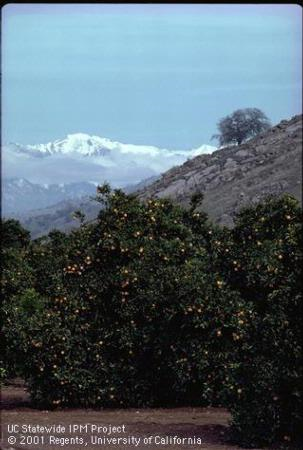
citrus and mountains
Posted on
Monday, September 25, 2017 at
7:02 AM


